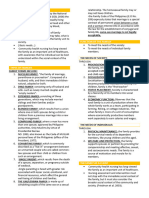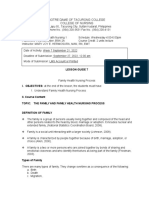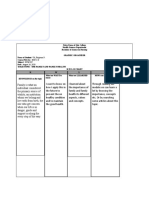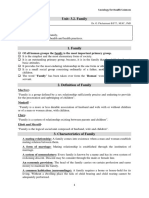CHN Notes
CHN Notes
Uploaded by
John Carl Obligacion0 ratings0% found this document useful (0 votes)
19 views5 pagesThis document discusses families and family health. It defines family and describes different types of families based on composition, locus of power, place of residence, and descent. It also outlines the functions, stages of development, and characteristics of healthy families. Finally, it lists the contents and principles of using a public health nurse's bag during home visits to provide care.
Original Description:
CHN notes Second year
Original Title
CHN-NOTES
Copyright
© © All Rights Reserved
Available Formats
DOCX, PDF, TXT or read online from Scribd
Share this document
Did you find this document useful?
Is this content inappropriate?
Report this DocumentThis document discusses families and family health. It defines family and describes different types of families based on composition, locus of power, place of residence, and descent. It also outlines the functions, stages of development, and characteristics of healthy families. Finally, it lists the contents and principles of using a public health nurse's bag during home visits to provide care.
Copyright:
© All Rights Reserved
Available Formats
Download as DOCX, PDF, TXT or read online from Scribd
Download as docx, pdf, or txt
0 ratings0% found this document useful (0 votes)
19 views5 pagesCHN Notes
CHN Notes
Uploaded by
John Carl ObligacionThis document discusses families and family health. It defines family and describes different types of families based on composition, locus of power, place of residence, and descent. It also outlines the functions, stages of development, and characteristics of healthy families. Finally, it lists the contents and principles of using a public health nurse's bag during home visits to provide care.
Copyright:
© All Rights Reserved
Available Formats
Download as DOCX, PDF, TXT or read online from Scribd
Download as docx, pdf, or txt
You are on page 1of 5
Community Health Nursing NCM 014
Family Provides newlywed couple the freedom
Definition of Family to select where to reside., i.e. near the groom’s
I. A group of persons usually living or the bride’s parents.
together and composed of the head and d. Neolocal family
other persons related to the head by Permits the newlywed couple to reside
blood, marriage or adoption. on their own as far as their residence is
II. A social unit interacting with the concerned.
larger society. e. Avunlocal family
III. Two or more persons who are joined Prescribes the newly-wed couple
together by bonds of sharing and resides with or near the maternal uncle of the
emotional closeness and who identify groom.
themselves as being part of family.
IV. A small social system and primary Based on Descent:
reference group made up of two or a. Patrilineal descent
more persons living together who are Affiliates a person with a group of
related by blood, marriage or adoption relatives related to him through his father.
or who are living together by b. Matrilineal descent
arrangement over a period of time. Affiliates a person with a group of
Murray and Zentner (1997). relatives related to him through his mother.
c. Bilateral descent
Types of Family (Filipino Family) The relatives on the mother’s side and
1. Based on Composition father’s side are equally important for
2. Based on Locus of Power emotional ties or for transfer of property or
3. Based on Place of Residence wealth.
4. Based on Descent FUNCTIONS OF FAMILY
PROCREATION
Based on Composition: STATUS ECONOMIC
SOCIALIZAT
a. Nuclear Family PLACEMEN PLACEMEN
ION
b. Dyad Family T T
c. Blended Family
d. Extended Family Family as a Client
e. Compound Family “ The family is a critical resource”
f. Gay or Lesbian Family The importance of the family in
g. Cohabiting Family providing care to its members has
h. Single Parent Family already been established. In this
Based on Locus of Power: caregiver role, the family can also
a. Patrifocal improve individual members’ health
b. Matrifocal through health promotion and wellness
c. Egalitarian activities.
d. Matricentric – is one where the “ In a family unit, any dysfunction
absence of the father who may be (illness, injury, separation) that affects one or
working gives the mother a dominant more family members will affect the members
position in the family. and unit as a whole”
Based on Place of Residence: Referred to as the “ripple effect”,
a. Patrilocal family changes in one member cause changes
When a newly married couple live with in the entire family. The nurse must
family of the bridegroom or near the residence assess each individual and the family
of the parents of the bridegroom. unit.
b. Matrilocal family “Case Finding”
When a newly married couple live with While assessing an individual and
or near the residence of the bride’s parents. family, the nurse may identify a health
c. Bilocal family problem that necessitates identifying
risks for the entire family.
“ Improving nursing care.”
The nurse can provide better and more V. The members engage in flexible role
holistic care by understanding the relationships, share power, respond to
family and its members. change, support the growth and
Family as a system autonomy of others, and engage
A way to explain how the family as indecision making that affects them.
a unit interacts with larger units outside the VI. The family teaches family and societal
family and with smaller units inside the family. values and beliefs and shares a spiritual
core. Healthy families foster responsibility
and value service to others.
Family as a system:
VII. Healthy families have a sense of play and
Parke (2002) 3 subsystems: humor and share leisure time. Healthy
1. Parent-child families have the ability to cope with stress
2. Marital and crisis and grow from problems. They
3. Sibling-sibling know when to seek help from
professionals.
Developmental Stages of a Family:
1. Beginning family through marriage or Tools of Public Health Nurse
commitment as a couple relationship PHN Bag and Contents
PRINCIPLES AND TECHNIQUES IN
2. Parenting the first child
THE USE OF PHN BAG
3. Living with adolescents The public health bag is an essential and
4. Launching family (youngest child indispensable equipment of a public health nurse
leaves home) which she has to carry along during her HOME
5. Middle-aged family (remaining marital VISIT. It contains basic medication and articles
dyad to retirement) which are necessary for giving care.
6. Aging family (from retirement to death The bag technique is a tool by which
of both spouses) the NURSE, during her visit will enable her to
Stages and tasks of the family life cycle: perform a nursing procedure with ease and deftness,
to save time and effort with the end view of
1. Marriage: joining of families rendering effective nursing care to clients.
2. Families with young children Principles
3. Families with adolescents Performing the bag technique will minimize, if not,
4. Families as launching centers prevent the spread of any INFECTION. It saves time
5. Aging families and effort in the performance of nursing procedures.
Family Health Tasks: The bag technique can be performed in a variety of
1. Recognizing interruptions of health or ways depending on the agency’s policy, the home
development. situation, or as long as principles of avoiding transfer
of infection is always observed.
2. Seeking health care.
CONTENTS OF PHN BAG:
3. Managing health and non health crises. Paper lining
4. Providing nursing care to sick, Extra paper for making waste bag
disabled, or dependent members of the Plastic/linen lining
family. Apron
5. Maintaining a home environment Hand towel
conducive to good health and personal Soap in a soap dish
development. Thermometers (oral and rectal)
6. Maintaining a reciprocal relationship 2 pairs of scissors (surgical and bandage)
2 pairs of forceps (curved and straight)
with the community and its health
Disposable syringes with needles (g. 23 &
institutions. 25)
7 Characteristics of Healthy Families Hypodermic needles (g. 19, 22, 23, 25)
I. Members interact with each other, they Sterile dressing
communicate and listen repeatedly in Cotton balls
many contexts. Cord clamp
II. Healthy families can establish Micropore plaster
priorities. Tape measure
III. Members understand that family needs 1 pair of sterile gloves
Baby’s scale
are priority. Alcohol lamp
IV. Healthy families affirm, support, and 2 test tubes
respect each other. Test tube holders
Solutions of:
Betadine70% alcohol cleaning them.
Zephiran solution Remove apron, folding it
Hydrogen peroxide away from the person, the
Spirit of ammnonia soiled side in and the clean
Ophthalmic ointment side out. Place it in the bag
Acetic acid Fold the lining, place it
Benedict’s solution inside the bag and Close the
bag.
Points to Consider: Mother. Write down all the
The bag should contain all the necessary articles, necessary data that were
supplies and equipment that will be used to answer gathered, observations,
the emergency needs For reference in the next
nursing care and treatment
The bag and its contents should be cleaned very visit
rendered. Give instructions
often, the supplies replaced and ready for use for care of patients in the
anytime. absence of the nurse.
The bag and its contents should be well protected Make appointment for the
from contact with any article in the patient’s home. next visit (either home or
Consider the bag and its contents clean and sterile, For follow-up care
clinic) taking note of the
while articles that belong to the patients as dirty and date and time
contaminated.
The arrangement of the contents of the bag should be TYPES OF FAMILY NURSE CONTACT
the one most convenient to the user, to facilitate CLINIC VISIT
efficiency and avoid CONFUSION. HOME VISIT
The following are steps in performing bag CLINIC VISIT:
technique and rationale for each action: The patient visits the Health Center/clinic to
avail of the services thereto offered by the facility
ACTION RATIONALE
primarily for consultation on matters that ailed them
Upon arrival at the patient’s physically. Nowadays, patients are becoming aware
home, place the bag on the of the other services that the Health Center offer such
table lined with a clean To protect the bag from as Pre-natal and post partum care , well baby check
paper. The clean side must getting contaminated up, immunization, free medicines under DOTS and
be out and the folded part, other health care.
touching the table.
Ask for a basin of water or Standard procedures performed during clinic visits:
To be used for hand I. Registration/Admission
a glass of drinking water if
washing 1. Greet the client upon entry and establish
tap water is not available
rapport.
Open the bag and take out To prepare for hand 2. Prepare the family record of new
the towel and soap washing
patients or retrieve records of old clients.
To prevent infection from 3. Elicit and record the client’s chief
Wash hands using soap and
the care provider to the complaint and clinical history.
water wipe to dry.
client 4. Perform physical examination on the
Take out the apron from the client and record it accordingly.
To protect the nurse’s
bag and put it on with the II. Waiting time
uniform
right side out. 1. Give priority numbers to ,clients.
Put out all the necessary 2. Implement the “First come, First served’
To have them readily
articles needed for the policy except for emergency/urgent ‘cases. .
accessible
specific care. Ill. Triaging
Close the bag and put it in 1. Manage program-based cases.
one corner of the working To prevent contamination 2. Refer all non-program based cases to the
area. physician. For all other cases which has no
Proceed in performing the To give comfort and potential danger, treatment/management is initiated
necessary nursing care and security and hasten by the nurse and she decides to do her own nursing
treatment recovery diagnosis and then refer to the physician for medical
After giving the treatment, management .
clean all thing that were To protect the caregiver 3. Provide first-aid treatment to emergency
used and perform and prevent infection cases and refer when necessary to , the next level of
handwashing care. ·
Open the bag and return all IV. Clinical Evaluation
things that were used in 1 . Validate clinical history and physical examination
their proper places after 2. The nurse arrives at evidence-based diagnosis and
provides rational treatment based on DOH programs.
a. identify the patient’s problem 3. In planning for a visit, we should consider and
b. formulate/write the nursing diagnosis give ,priority to the essential needs of the individual
and validate and his family.
c. give/perform the nursing intervention 4. Planning and delivery of care should involve the
d. evaluate the intervention if it has individual and family
enabled the patient to achieve the desired 5. The plan should be flexible.
outcome
3.Inform the client on the nature of the illness, the Guidelines to consider regarding the frequency of
appropriate treatment and prevention and control home visits:
measures. 1. The physical needs, psychological needs and
V. Laboratory and other diagnostic educational needs of the individual and family
examinations 2. The acceptance of the family for the services to be
Identify a designated referral laboratory when rendered, their interest and the willingness to
needed. cooperate
VI. Referral System 3. The policy of a specific agency and the emphasis
1. Refer the patient if he needsds further given towards their health programs
management following the two-way ·, referral 4. Take into account other health agencies and the
system (BHS to RHU, RHU to RHU, RHU to number of health personnel already involved in the
Hospital) . care of a specific family
2. Accompany the patient when an emergency 5. Careful evaluation of past services given to a
referral is needed. family and how the family avail of the nursing
VII. Prescription/Dispensing services
1. Give proper instructions on drug 6. The ability of the patient and his family to
intake recognize their own needs, their knowledge of
VIII. Health Education available resources and their ability to make use of
1.Conduct one-on-one counseling with the patient. their resources for their benefits.
2. Reinforce health education and counseling
messages Steps in conducting home visits
3. Give appointments for the next visit. 1. Greet the patient and introduce yourself
2. State the purpose of the visit
HOME VISIT: 3. Observe the patient and determine the health needs
The home visit is a family-nurse contact which 4. Put the bag in a convenient place then proceed to
allows the health worker to assess the home and perform the bag technique
family situations in order to provide the necessary 5. Perform the nursing care needed and give health
nursing care and health related activities. In teachings
performing this activity, it is essential to prepare a 6. Record all important data, observation and care
plan of visit to meet the needs of the client and rendered
achieve the best results of desired outcomes. 7. Make appointment for a return visit
Purpose of Home Visit:
1. To give nursing care to the .sick, to a NURSING CARE IN THE HOME
postpartum mother and her newborn with Principles in Nursing Care
the view to teach a responsible family 1. Nursing care utilizes a medical plan of care and
member to give the subsequent care. treatment.
2. To assess the living condition of the patient 2. The performance of nursing care utilizes skills that
and his family and their health practices in would give maximum comfort and security to the
order to provide the appropriate health individual.
teaching 3. Nursing care given at home should be used as a
3. To give health teachings regarding the teaching opportunity to the patient or to any
prevention and control of diseases. responsible member of the family.
4. To establish strong between the health 4. The performance of nursing care should recognize
agencies and the public for the promotion danger in the patient’s over-prolonged acceptance of
of health. support and comfort .
5. To make use of the inter-referral system 5. Nursing care is a good opportunity for detecting
and to promote the utilization of abnormal signs and symptoms, observing patient’s
community services. attitude towards care given and the progress
exhibited by the patient.
Principles involved in preparing for a home visit
1. A home visit must have a purpose or objective Isolation Technique in the Home:
2. Planning for a home visit should make use of all 1 . All articles used by the patient should not be
available information about the patient and his mixed with the articles used by the rest of the
family through family records. members of the household.
2. Frequent washing and airing of beddings and other
articles and disinfection of room are imperative.
Abundant use of soap, water, sunlight and some
chemical disinfectants is necessary.
3. The one caring for the sick member should be
provided with a protected gown that should be used
only within the room of the sick.
4. All discharges, especially from the nose and throat
of a communicable disease patient, should be
carefully discarded.
5. Articles soiled with discharges should first be
boiled in water 30 minutes before laundering. Those
could be burned, should be burned.
You might also like
- Family Health NursingDocument17 pagesFamily Health NursingMIKAELLA BALUNANNo ratings yet
- The Family Definition and Concepts of FamilyDocument6 pagesThe Family Definition and Concepts of FamilyMikhaela Andree MarianoNo ratings yet
- The Family, The Fundamental Unit of ServiceDocument5 pagesThe Family, The Fundamental Unit of ServiceXandra BasnilloNo ratings yet
- KHJGFDFGDocument17 pagesKHJGFDFGNicole RomeroNo ratings yet
- MaternalDocument11 pagesMaternalAlyssa Kate Husain SaludesNo ratings yet
- Output 3 - Family Health NursingDocument9 pagesOutput 3 - Family Health Nursingromelyn100% (1)
- Community Health NursingDocument6 pagesCommunity Health NursingKimberly DerigeNo ratings yet
- CHN RLE Outline of LessonsDocument10 pagesCHN RLE Outline of LessonsKyle FernandezNo ratings yet
- Erika Jane Trajano Lesson No. 3 Family Structures and LegacyDocument5 pagesErika Jane Trajano Lesson No. 3 Family Structures and LegacyJoshua Albert CastroNo ratings yet
- Module 3 Family Health NursingDocument44 pagesModule 3 Family Health Nursing17melrosefloresNo ratings yet
- FamilyDocument10 pagesFamilyMacy DysancoNo ratings yet
- Module 3 Family Health Nursing Final LastDocument5 pagesModule 3 Family Health Nursing Final LastAmethystNo ratings yet
- CHN Files Complete 1Document316 pagesCHN Files Complete 1ASTR4 BABYNo ratings yet
- Family Medicine: Is A Specialty of MedicineDocument4 pagesFamily Medicine: Is A Specialty of MedicineJonathan PacunayenNo ratings yet
- CHN The FamilyDocument5 pagesCHN The FamilyFavila, Hazel, J. BSN-1CNo ratings yet
- CHN Family TRANSESDocument1 pageCHN Family TRANSESQueen RiquezNo ratings yet
- Module 6 With Activities - NCM 104Document14 pagesModule 6 With Activities - NCM 104Jann ericka JaoNo ratings yet
- Procreation - Socialization of The Family MemberDocument3 pagesProcreation - Socialization of The Family Memberkazelle GentallanNo ratings yet
- CHN NotesDocument12 pagesCHN Notestt9zx27kmjNo ratings yet
- PD Module 10Document9 pagesPD Module 10DAPHNEE MAE AGUDONGNo ratings yet
- CHN211 Week 4 WORD - Family Health NursingDocument8 pagesCHN211 Week 4 WORD - Family Health NursingCay ObejeroNo ratings yet
- The FamilyDocument71 pagesThe Familyjs6mqq5rycNo ratings yet
- Levels of ClienteleDocument8 pagesLevels of Clienteleelle belloNo ratings yet
- Family Health Care ProcessDocument13 pagesFamily Health Care ProcessAl-waleed JulkanainNo ratings yet
- CHN1 - Lesson Guide 7Document12 pagesCHN1 - Lesson Guide 7Yahra DatangNo ratings yet
- Community Health NursingDocument11 pagesCommunity Health NursingIligan, Jamaicah100% (1)
- Family As A Unit of CareDocument77 pagesFamily As A Unit of CareJeanne Marie ValesNo ratings yet
- Activity 2. MODULE 1Document12 pagesActivity 2. MODULE 1Rujiyana P. UliNo ratings yet
- Maternal Notes 1Document7 pagesMaternal Notes 1ubrieubrieNo ratings yet
- Family Study ProformaDocument15 pagesFamily Study Proformamfzrxk5wgdNo ratings yet
- Family OrientedDocument2 pagesFamily OrientedJennica BubanNo ratings yet
- Week 1 - CHN Lec NotesDocument3 pagesWeek 1 - CHN Lec Notescuteathena11No ratings yet
- CORE - 1112 - SemIII - PERDEV - CLAS4 - Family Structure - v5FOR QA XANDRA MAY ENCIERTO RHEA ANN NAVILLADocument15 pagesCORE - 1112 - SemIII - PERDEV - CLAS4 - Family Structure - v5FOR QA XANDRA MAY ENCIERTO RHEA ANN NAVILLAJay Lagan GomezNo ratings yet
- Chapter-3-The-Childbearing-and-Childrearing-Family-in-the-CommunityDocument48 pagesChapter-3-The-Childbearing-and-Childrearing-Family-in-the-CommunityAllison Faith QuezonNo ratings yet
- Maternal and Child Nursing Reviewer!!!!!!!Document2 pagesMaternal and Child Nursing Reviewer!!!!!!!Oscar CruzNo ratings yet
- MODULE 01 UNIT I Family Family HealthDocument9 pagesMODULE 01 UNIT I Family Family HealthGaspay GillianeNo ratings yet
- Family: Characteristics of A Healthy FamilyDocument14 pagesFamily: Characteristics of A Healthy FamilyRoyce Vincent TizonNo ratings yet
- ACTIVITY 02 CONCEPT The FamilyDocument5 pagesACTIVITY 02 CONCEPT The FamilyMeiji DelfierroNo ratings yet
- Family As A Unit of CareDocument5 pagesFamily As A Unit of CareMonsour SalazarNo ratings yet
- Concept On Family HandoutDocument16 pagesConcept On Family Handoutchip chipsNo ratings yet
- The Family - Community Heath NursingDocument8 pagesThe Family - Community Heath NursingJASMIN ROSE SALSESNo ratings yet
- The Family and Family HealthDocument52 pagesThe Family and Family HealthBhie BhieNo ratings yet
- CONCEPT OF FAMILY-Family Nursing ProcessDocument9 pagesCONCEPT OF FAMILY-Family Nursing ProcessJunry PilapilNo ratings yet
- Module 2 The FamilyDocument26 pagesModule 2 The FamilyFrancine De Los Reyes100% (1)
- 117 Week 2Document3 pages117 Week 2Corpus, Irene Zen P.No ratings yet
- Inbound 2089486514387269334Document8 pagesInbound 2089486514387269334Christian BorcesNo ratings yet
- NCM107 Lecture 1 Framework of MCNDocument3 pagesNCM107 Lecture 1 Framework of MCNChristian Karl Joshua RamosNo ratings yet
- Maternal and Child Health NursingDocument9 pagesMaternal and Child Health NursingCassandra NicoleNo ratings yet
- Unit - V Spiritual Needs of Children and FamiliesDocument10 pagesUnit - V Spiritual Needs of Children and FamiliesPeng MyouiNo ratings yet
- Payanay Fatima May E. Bsn-2A // CHN LecDocument4 pagesPayanay Fatima May E. Bsn-2A // CHN LecMarielle AcojidoNo ratings yet
- UnvghjnnntitledDocument10 pagesUnvghjnnntitledkeerthi sivayanamaNo ratings yet
- CHN ReviewDocument4 pagesCHN ReviewLaicka Jenell DionglayNo ratings yet
- FMC201 S1T1 Prelim Family System 2021Document6 pagesFMC201 S1T1 Prelim Family System 2021Aj Christian Lacuesta IsipNo ratings yet
- Journeying Back To One FamilyDocument4 pagesJourneying Back To One FamilyMark Adrian ArenasNo ratings yet
- FAMILYDocument8 pagesFAMILY2230299No ratings yet
- Principles of SociologyDocument6 pagesPrinciples of SociologybharaligeetuNo ratings yet
- Module 1 Maternal LectureDocument4 pagesModule 1 Maternal LectureMa Christina RovillosNo ratings yet
- Primary Health Care 1: Health Care Process As Applied To The Family 1Document59 pagesPrimary Health Care 1: Health Care Process As Applied To The Family 1juanamay30gmailcomNo ratings yet



























































